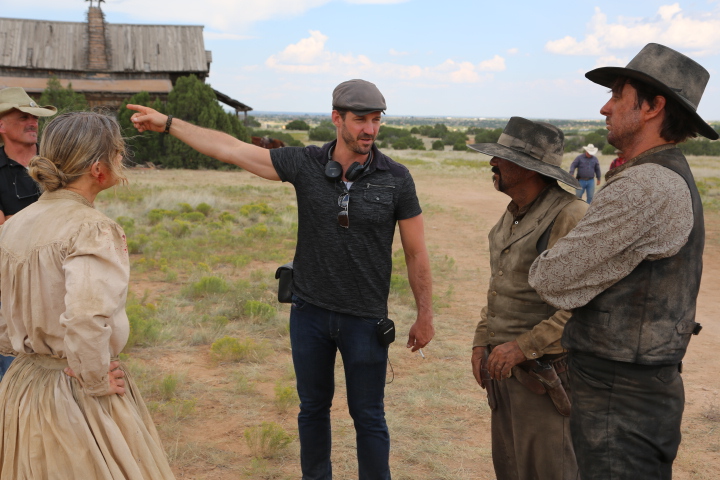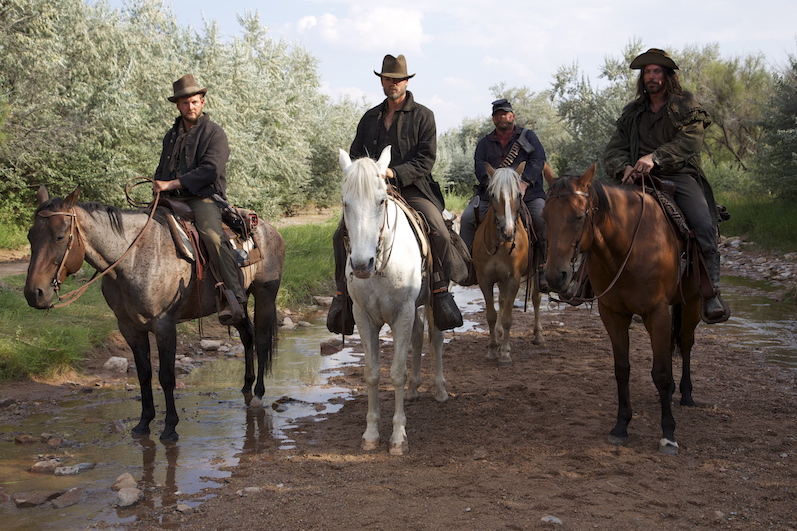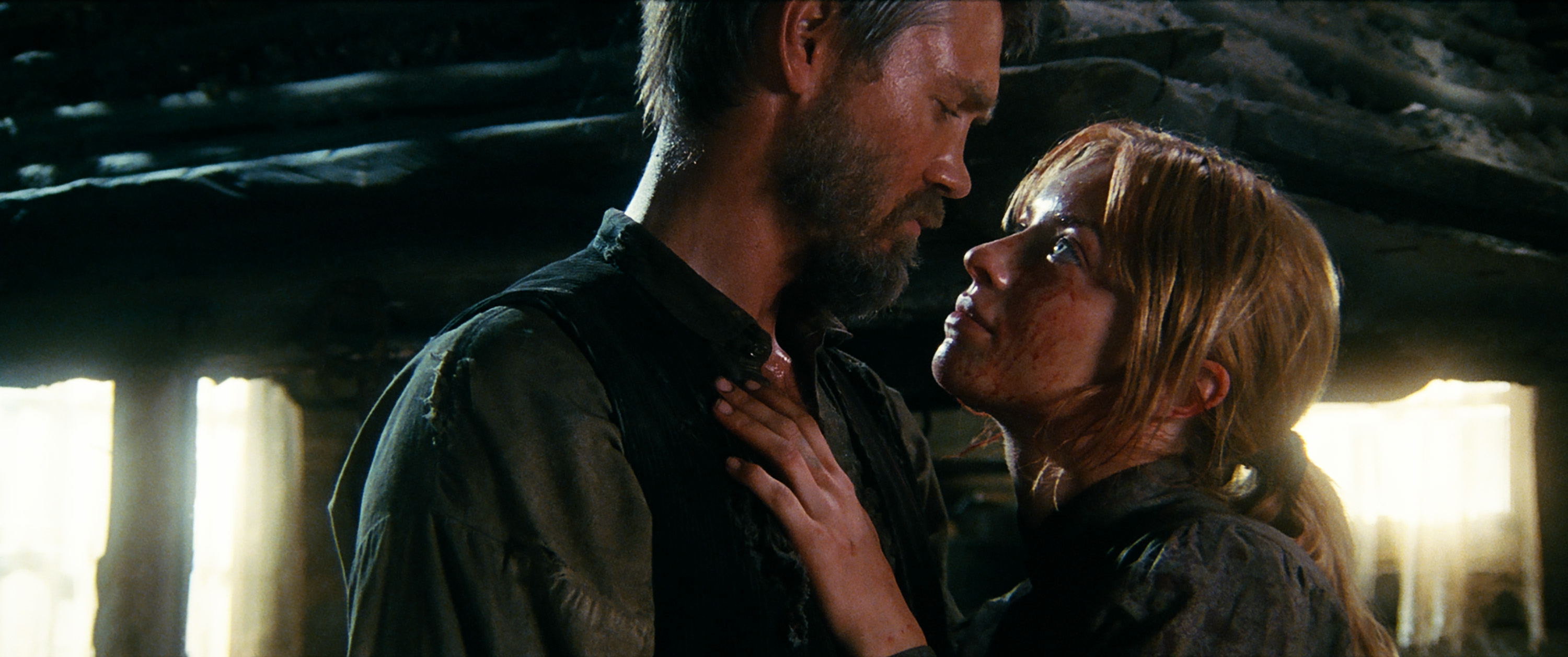
Considering his family trade, it’s no huge surprise that JT MOLLNER grew up to be a filmmaker. His parents operated a haunted house business during Halloween season in Nevada, where JT grew from child performer to adult manager. After relocating to LA and transitioning from actor to director, Mollner made a string of successful short films – including Henry John and the Little Bug, Sugartown, and Flowers in December – before making the leap to features.
Mollner debuted his 35mm-filmed Western OUTLAWS AND ANGELS at the 2016 Sundance Film Festival. Outlaws and Angels follows a violent gang of bank robbers led by Henry (Chad Michael Murray) as they take refuge in the home of a frontier family while hiding from the law. But this family of hostages has their own secrets to hide, as well as a rebellious daughter (Francesca Eastwood) who quickly catches Henry’s eye. After Sundance, Momentum Pictures picked up distribution rights and will release the film in theaters and iTunes/VOD on July 15. Outlaws and Angels co-stars Teri Polo, Madisen Beaty, Ben Browder, Frances Fisher, Keith Loneker, and Luke Wilson.
On the afternoon of the film’s Los Angeles premiere, writer/director JT Mollner spoke with us about his feature directorial debut, including some advice for low-budget directors looking to shoot on film, his filmmaking influences, and why he loves to cast actors against type.
——
COLIN McCORMACK: I wanted to talk about the Western genre a little bit, which is a big-tent kind of genre. And it seems like indie films over the past couple years have really evolved it and pushed it in different directions and added different elements to the genre. I was wondering with the feminist slant and the contained thriller elements of Outlaws and Angels, what other movies and genres inspired you and made you want to mash it up with a Western?
JT MOLLNER: I think the starting place of my biggest influence as a filmmaker is early Polanski. And so I knew my first movie was going to be a little bit of a claustrophobic experience, and I just felt drawn to Knife in the Water and Cul-De-Sac and Repulsion-type stories. I never really saw myself making a “genre” type movie necessarily, or a Western or a horror movie or anything like that. I thought my first film would be a similar story to what you see here, except outside of any confines of any genre. But I got excited– I’m a fan of Westerns, I grew up watching everything from John Ford to Sam Peckinpah. Westerns were always kind of a comfort food. But when I would watch Westerns by Sam Peckinpah, for instance, and I saw more of a dirty element, more of a realism, more of a direct result of violence being shown, it excited me. So I started getting really into those revisionist Westerns as the years went on, and I’d still up until the time I wrote [Outlaws and Angels] never really seen certain envelopes being pushed in that genre. So I thought it was an ideal genre to play in for a first feature. And I thought that some of this subject matter, some of the things that were taking place-– I did a lot of research on that time period for the dialogue and the story and there were some awful, incredibly insidious things happening way in the cozy confines of the frontier in that period. I found out that there was incest, there was abuse, there were all kinds of things happening because nobody was being regulated. Some people were good people, but some people just let the worst come out. And that was fascinating to me, because every Western I’d seen before had a very clear good versus evil message.
CM: White hats and black hats.
JM: Exactly. Always. And so I thought, Why don’t we set up all those traditional archetypes: The bounty hunter, the outlaws, the frontier family; all in the first act and then start peeling those layers away as the movie goes on. And it was always important for me to inject a feminist element. One of my favorite movies in the last ten years is A Girl Walks Home Alone at Night, and so I really appreciated what [director Ana Lily Amirpour] did with that film and I wanted to make sure that I had thematically similar choices made in my first film. I knew it was going to be a very different movie from that movie, but thematically it was important to me to be part of that. Because a lot of people are realizing now that women are being underutilized in town, and when they are utilized it’s as somebody’s girlfriend and the character barely has any development. So I thought we’d have a great traditional role [from] Shane [into] The Dark Tower-type of character, but we’d also have this great surprise lead who comes to the surface and grows as we watch her, and that was the goal with [Francesca Eastwood’s] Florence.
And outside of all that it was important for me to forget we were making a Western when we were shooting. I wanted to shoot it in the style that I was inspired by: Post-modern cinema from Europe. Not Westerns from Europe, but films by Bergman and Polanski and Fellini. I love those long takes and I love those two-shots instead of general coverage and I love moving the camera and zooming. I got addicted to the zoom lens during this film, as you probably noticed, because I wanted to get those close-ups during those long takes and it started to become kind of a character in the movie. So I think this is an amalgamation of all my influences, and we tucked it into a Western. But I think the Western packaging is what makes it unique.
CM: Was there ever – from a budgetary standpoint – pressure to keep it just that claustrophobic, inside-the-frontier-home and no [exterior] sets?
JM: [Laughs] There was. Chris Ivan Cevic produced the movie with me on-set and was in charge of figuring those budgetary concerns out, along with Mykel Denis our line producer. One of our main producers Rosanne Korenberg produced Half Nelson but also a movie called Hard Candy that you probably saw.
CM: Yes.
JM: That movie had almost the same budget – I think maybe even a little more money – than Outlaws and Angels did. And that film was two actors in a contemporary location for the whole movie. So I will say the first draft of the script I wrote was almost all inside that inside location. And I said, Okay here’s the movie: Inside, this many actors, we can shoot it for this amount of money. Then as I started writing new drafts of the script, started wanting to open it up a little bit. Chris got angry with me.
[Mollner and producer Chris Ivan Cevic both laugh]
JM: People working on the film were like, Whoa, this isn’t really that same movie anymore. And by the time we shot the movie, we realized we bit off almost more than we could chew. A lot of people had to sacrifice a lot of pay and stuff to get it made. The movie we finished with, although there is a lot inside that one location, there’s a good thirty-five to forty-percent of the movie that’s outside too. We just spend an entire act in that location, so it feels like we’re there longer than we are. It’s a bigger movie than we would have liked to make at this budget and I will never do it again. [Laughs] And in hindsight, we would have done something different with that kind of budget, but I’m just glad it’s done and I’m glad we got what we got on the screen. If I knew how hard it was going to be maybe we wouldn’t have done it, but I just love how the movie looks now and it’s exactly how I wanted it to be. So we found a way.

CM: Speaking of the look, with shooting on film, do you have tips or advice for low-budget filmmakers who probably assume that film is cost-prohibitive under a certain budget?
JM: Yes. I recommend always shooting film no matter what your budget, unless it’s $10. If you have $100,000 you can find a way to shoot film. I really believe if you’re interested in doing it, don’t listen to everybody out there who’s saying it’s impossible or it’s too expensive. Call Kodak and get their advice. Figure out if it’s a fit for you. Because I truly believe on our film that we would have spent more money if we shot on video. All people are really looking at is a line item scenario; they’re looking at how much film costs, how much processing costs. But they’re not looking at how much you save with a better crew who will work for cheaper. They’re not looking at how much you save when you work with actors who are excited to be shooting on film and how focused people are on set. I mean, we were so efficient and our shooting ratio was phenomenal. It was out of control.
CHRIS IVAN CEVIC: It was 7:1.
JM: Yeah, it was 7:1! A lot of these guys are shooting 24:1 or 30:1. And I really know that [efficiency] wouldn’t have happened if we hadn’t been shooting film, if everybody hadn’t been able to hear the celluloid on set. Our crew and cast were so focused. So in the end I do believe actually it was cheaper for us to shoot on film. And aesthetically it’s so important. Everybody has different tastes, and some people will think the movie looks horrible and some people will think it looks amazing. I’ve heard people say “beautiful” and “beyond belief” about the way the movie looks, and I’ve heard people who don’t have an eye for [film] say it looks “cheap,” because obviously the grain and the dirt can appear cheap to some people. In this day and age it’s expensive to get that look. So for us, we really wanted this movie to look like it was pulled out of a vault from the ‘60s. And we didn’t want to do that with post-production tricks and added grain and all these things that to me don’t sell. We wanted to do it the real way. And we saved a lot of money in post because of what was captured. We had to do a little bit – you always do a little color pass – but we didn’t spend countless hours and days making the movie look how we wanted to look, because that’s the way we captured it.
CIC: Can I speak to this question as well?
CM: Yes, please.
CIC: I think there was a story to tell when we approached every single person about this. And when we told them what we were doing: That we were shooting on vintage lenses and we were shooting on Kodak and we want to be really dirty and we want to do a Spaghetti Western; there was something really romantic about that. It’s not like, “I’m going to go work on Independence Day because it’s a $150 million blockbuster.” It’s, “I’m going to go work on what could be one of the most unique things going or available to me at this time.” There was that draw, where everyone who could have left for bigger money and bigger opportunities, they came to our little film. And everyone on our set by the end of it, they were like, We’re so grateful that we chose your little movie and your little paycheck, because it’s going to be the one we’re most proud of.
CM: Was it a fight when going to financiers? Was there a lot of, We’ll give you the money if you agree to shoot digital? Or coming out of the gate before a meeting happened did they know it was going to be film?
JM: I knew and Chris knew and Rosanne knew – my team, my partners – when we went out to look for financing, they knew there was nothing that would stop me from shooting film. I’m one of those crazy purists. So they knew, as I said behind closed doors I’d rather not make the movie than not shoot it on film. So I knew where I was with it. But we were told by investors [and] certain reps for investors that if you’re shooting film, we won’t finance the movie. And they ended up doing it anyway. You just gotta stand your ground and you gotta go to them with statistics. For me, my biggest argument was that I’d never shot video. I shot video on a couple early short films, but for the most part all my substantial work has been done on film. So I feel like I wouldn’t have been as good on a video set. I told them, This is what we’re used to doing. Chris and I have done tons of projects on film and we’re most comfortable with that. And we also got [cinematographer] Matthew Irving, which probably helped. He’s a legendary DP and he’s shot a lot of film, and so when we brought him on I think that put their mind at ease. And you can’t go in and say, Screw you I’m going to shoot film, and not back it up. You’ve got to go in with a plan. And if you call Kodak, they’ll give you a plan. They’ll help you. They’ll talk to you about it. It’s really important to them now. You know, the big-budget movies are still shooting film, a lot of them. Batman v. Superman, Spider-Man, these movies are shooting film because they can afford it and they know it’s superior. But it’s the low-budget market that’s being lost. So Kodak’s made a concerted effort in the last couple years to go after the indies again. So they’ll embrace you with open arms if you call them, and they’ll help you argue it and they’ll give you the tools.
CM: To talk about your cast for a little bit, a lot of them seem to be cast against type, like Luke Wilson and Chad Michael Murray and Teri Polo. And also with your last film with Dee Wallace-
JM: Did you see that? It hasn’t been released yet-
CM: I haven’t, but even the still photos of her as this hard-edged lady with a cigarette and tats. It’s not the E.T. or Cujo lady I remember.
JM: She’s so good in it.
CM: Has casting actors against type just been happenstance, or is it something you actively are thinking about when you’re gathering a cast for your films?
JM: I’ll say this experience has made me actively think about it. I like it a lot, because I’ve realized that when you cast against type, you have hungry actors who will never phone it in. And they’re just with you and completely committed to the process. Ben Browder was cast against type. Teri Polo-
CM: Teri Polo is unbelievable in this.
JM: Unbelievable. She’s Oscar-worthy to me. I just think all these people– and it’s hard for me to do interviews because I want to name all of them. Madisen Beaty was just so subtle and incredible. And Chad and Francesca. Keith Loneker, I mean he’s a smart guy! If you have a conversation with him, he’s a really intelligent guy and he’s playing this doofus. For me, I realized – to answer your question – for one, you’ll get people interested in your script. When you’re going out with a new script and you’re a new director and you don’t have a lot of money to make your movie, you’ll attract attention if you are willing to cast against type because people want that shot. But now that I’ve done it and I’ve seen the results and I’ve seen how hard people work when you give them a shot to do something different, I’m not interested in casting people who have played the archetype before. Because I don’t want to work with people who are lazy and I don’t want to work with anybody who shows up and phones it in because we’re casting– whoever it is, I don’t want to alienate any actors I might want to work with. Whoever I bring in, I’d like to give them something new to do from now on. So if that’s against typecasting, then I’m going to be doing it from now on.
And now there are so many places my mind goes, like with Chad for instance. I’m writing a number of new things and planning my next project and I know that I want to work with almost all these people again. So there’s a part right now I’m thinking about for Chad, that if you told me Chad Michael Murray for this role two years ago, I never would have thought about him for it. But it’s much different from what he did in Outlaws, and I know that he can handle anything, so I can’t wait to see what the result is. It’s an interesting and exciting thing for me to see happen, to see these actors become different characters. I think the best actors all have character acting within them, and why not let them do what they’re best at? It’s a marvel to see.
CM: And quickly, I know your production company is called No Remake Pictures. With no budget limitations, full complete control, is there any movie that you’d want to take a crack at remaking?
JM: I’d do a sequel, although I’d prefer not to. But if I really loved a film and thought there was a need for a sequel, like maybe one day if there was a great horror film that I wanted to give a good sequel to, I’m not against sequels. I love that there’s going to be a new Indiana Jones coming out and Harrison Ford is going to be eighty or however old-
[Cevic laughs]
JM: I love that stuff! I mean, people age! There’s ageism and sexism in Hollywood. And I love female leads and I love older people playing characters– there’s no reason to age people out of roles. So I love sequels, if they’re good. But I don’t foresee– I can’t imagine ever doing a remake. And the reason I named my production company No Remake Pictures is to keep me honest. So as long as I keep making the films I want to make and am able to make a living doing that, there wouldn’t be an amount of money that would suck me into a remake.

__
Thanks to JT (and Chris) for talking with us! For more information on OUTLAWS AND ANGELS, follow the film on Twitter or Instagram, or visit JT Mollner’s No Remake Pictures on Facebook.
If you’re an independent filmmaker or know of an independent film-related topic we should write about, email blogadmin@sagindie.org for consideration.
